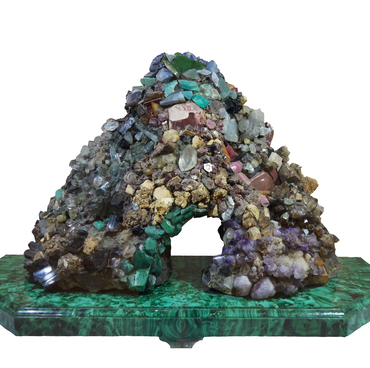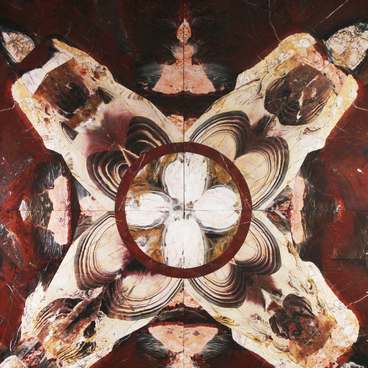The collection of the Museum of Stone-Cutting and Jewelry Art History houses a decorative panel made of natural stone “Bright Midday”. It is made in the Florentine mosaic technique. The sketch for this work was created in 1995 by chief artist of the Sverdlovsk plant “Russkiye Samotsvety” (Russian Gemstones) Yevgeny Vasilyev. Masters I. S. Pogodin, V. V. Klevakin, V. N. Torkhov did stonework. In 1996, I. S. Pogodin donated it to the Museum of Stone-Cutting and Jewelry Art History.
Florentine mosaic is considered one of the most difficult techniques. The varieties and shades of stones are carefully selected; special attention is paid to their naturally formed patterns. The individual plates are pierced together so tightly that the seams between them are almost invisible. This art originated in Italy in the 16th century, and by the middle of the 18th century, the first Florentine mosaics were brought to Russia. Ural craftsmen learned to make their own items based on foreign samples.
In Soviet times, the Florentine mosaic became popular again, but then they did not make miniature items from it, but only huge canvases, the area of which reached several hundred square meters. Such images were used to decorate the facades of buildings, ceilings and walls of metro stations.
The base on which such mosaic paintings are assembled is usually marble or slate. Masters also outline with it the water surface on the image itself. Traditionally, in the Urals, many different varieties of jasper are used when working in this technique, as they allow to imitate different surfaces, create smooth or contrasting color transitions. Depending on the variety, jasper can be green, gray, yellow, red, solid, striped or speckled. Only blue stones of this type are not found in nature.
The panel “Bright Midday” depicts a simple Ural landscape: a river with wooden bridge across it, and a birch grove on the other side. To represent the shades of greenery on the trees, the authors used verd antique (ophite) — an ornamental stone similar in structure to marble. It was supplemented with other green minerals: serpentinite or listwanite. The bridge and wooden poles on the river’s bank are made of light jasper; reeds are made of dark brown jasper.
Florentine mosaic is considered one of the most difficult techniques. The varieties and shades of stones are carefully selected; special attention is paid to their naturally formed patterns. The individual plates are pierced together so tightly that the seams between them are almost invisible. This art originated in Italy in the 16th century, and by the middle of the 18th century, the first Florentine mosaics were brought to Russia. Ural craftsmen learned to make their own items based on foreign samples.
In Soviet times, the Florentine mosaic became popular again, but then they did not make miniature items from it, but only huge canvases, the area of which reached several hundred square meters. Such images were used to decorate the facades of buildings, ceilings and walls of metro stations.
The base on which such mosaic paintings are assembled is usually marble or slate. Masters also outline with it the water surface on the image itself. Traditionally, in the Urals, many different varieties of jasper are used when working in this technique, as they allow to imitate different surfaces, create smooth or contrasting color transitions. Depending on the variety, jasper can be green, gray, yellow, red, solid, striped or speckled. Only blue stones of this type are not found in nature.
The panel “Bright Midday” depicts a simple Ural landscape: a river with wooden bridge across it, and a birch grove on the other side. To represent the shades of greenery on the trees, the authors used verd antique (ophite) — an ornamental stone similar in structure to marble. It was supplemented with other green minerals: serpentinite or listwanite. The bridge and wooden poles on the river’s bank are made of light jasper; reeds are made of dark brown jasper.


